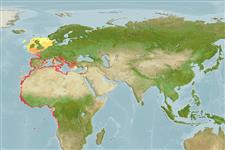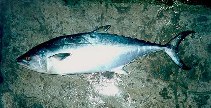Orcynopsis unicolor (GeoffroySaint-Hilaire, 1817)
Plain bonito
Добавить Ваши наблюдения в Fish Watcher
| Native range | All suitable habitat | Point map | Year 2050 |

|
| This map was computer-generated and has not yet been reviewed. |
| Orcynopsis unicolor AquaMaps Data sources: GBIF OBIS |
Загрузить свой Фото и Видео
Pictures | Изображение на GoogleOrcynopsis unicolor
Picture by Meyer, T.
Pictures | Изображение на GoogleOrcynopsis unicolor
Picture by Meyer, T.
Senegal country information
Common names:
Palomète, Sipon
Occurrence: native
Salinity: brackish
Abundance: | Ref:
Importance: | Ref:
Aquaculture: | Ref:
Regulations: | Ref:
Uses: no uses
Comments: Occurs in Sine-Saloum Estaury and Casamance River (Ref. 28587).
National Checklist:
Country Information: https://www.cia.gov/library/publications/resources/the-world-factbook/geos/sg.html
National Fisheries Authority: http://www.refer.sn/sngal_ct/eco/oeps/
Occurrences: Occurrences Point map
Main Ref: Collette, B.B. and C.E. Nauen, 1983
National Database:
Occurrence: native
Salinity: brackish
Abundance: | Ref:
Importance: | Ref:
Aquaculture: | Ref:
Regulations: | Ref:
Uses: no uses
Comments: Occurs in Sine-Saloum Estaury and Casamance River (Ref. 28587).
National Checklist:
Country Information: https://www.cia.gov/library/publications/resources/the-world-factbook/geos/sg.html
National Fisheries Authority: http://www.refer.sn/sngal_ct/eco/oeps/
Occurrences: Occurrences Point map
Main Ref: Collette, B.B. and C.E. Nauen, 1983
National Database:
Common names from other countries
Классификация / Names народные названия | синонимы | Catalog of Fishes(род, виды) | ITIS | CoL | WoRMS | Cloffa
> Scombriformes (Mackerels) > Scombridae (Mackerels, tunas, bonitos) > Scombrinae
Etymology: Orcynopsis: Greek, orkynos, -ou = a kind of tunna + Greek, opsis = similar to (Ref. 45335).
Etymology: Orcynopsis: Greek, orkynos, -ou = a kind of tunna + Greek, opsis = similar to (Ref. 45335).
Environment: milieu / climate zone / depth range / distribution range экология
морской; солоноватоводный; мигрирует в океане (Ref. 51243); пределы глубины 4 - ? m (Ref. 122150). Subtropical; 60°N - 13°S, 18°W - 36°E
распространение страны | регионы FAO | Ecosystems | места находок | Point map | интродукции | Faunafri
Eastern Atlantic: Oslo, Norway south to Dakar, Senegal but the range is centered in the southern Mediterranean Sea. Not known from Madeira, the Canary Islands or Cape Verde.
Length at first maturity / Size / Вес / Возраст
Maturity: Lm 75.0, range 70 - 80 cm
Max length : 130 cm FL самец/пол неопределен; (Ref. 168); common length : 90.0 cm FL самец/пол неопределен; (Ref. 168); наибольший вес (опубликованные данные): 13.1 kg (Ref. 168)
Max length : 130 cm FL самец/пол неопределен; (Ref. 168); common length : 90.0 cm FL самец/пол неопределен; (Ref. 168); наибольший вес (опубликованные данные): 13.1 kg (Ref. 168)
Краткое описание определительные ключи | морфология | морфометрия
колючие лучи спинного плавника (общее число) : 12 - 14; членистые (мягкие) лучи спинного плавника (общее число) : 12 - 15; членистые (мягкие) лучи анального плавника: 14 - 16. Mouth rather large, upper jaw reaching to hind margin of eye. Laminae of olfactory rosette 25 to 28. Interpelvic process small and bifid. Body naked behind the well developed corselet. Swim bladder absent. Vertebrae 17 or 18 precaudal plus 19 to 21 caudal, total 37 to 39. Anterior three quarters of first dorsal fin black.
Adults are neritic, confined primarily to temperate waters, but juveniles may be encountered in waters of up to 30°C. Form small schools at the surface so that the first dorsal fin stands out of the water like that of sharks, also frequently associated with birds. Feed on small fishes, especially sardines, anchovies, jacks, mackerel, bogue and others. Eggs and larvae are pelagic (Ref. 6769). Marketed canned or frozen.
Life cycle and mating behavior половая зрелость | размножение | нерест | икра | Fecundity | личинки
A female weighing 5 or 6 kg may carry some 500 to 600,000 eggs which are spawned in portions.
Основная ссылка
Upload your references | ссылки | координатор : Collette, Bruce B. | соавторы
Collette, B.B. and C.E. Nauen, 1983. FAO Species Catalogue. Vol. 2. Scombrids of the world. An annotated and illustrated catalogue of tunas, mackerels, bonitos and related species known to date. Rome: FAO. FAO Fish. Synop. 125(2):137 p. (Ref. 168)
Статус Красного Списка МСОП (Ref. 130435: Version 2024-1)
Не вызывающий беспокойства (LC) ; Date assessed: 01 March 2022
Угроза для людей
Harmless
Использование человеком
рыболовство: не имеет хозяйственного значения; объект спортивного рыболовства: да
FAO(рыболовство: production; publication : search) | FishSource | Sea Around Us
дополнительная информация
Population dynamics
Growth parameters
Max. ages / sizes
Length-weight rel.
Length-length rel.
Размерный состав
Mass conversion
пополнение
численность
Growth parameters
Max. ages / sizes
Length-weight rel.
Length-length rel.
Размерный состав
Mass conversion
пополнение
численность
Life cycle
размножение
половая зрелость
Fecundity
нерест
Spawning aggregations
икра
Развитие икры
личинки
динамика численности личинок
размножение
половая зрелость
Fecundity
нерест
Spawning aggregations
икра
Развитие икры
личинки
динамика численности личинок
Anatomy
жаберная область
Brain
Otolith
жаберная область
Brain
Otolith
Physiology
Body composition
Nutrients
Oxygen consumption
Swimming type
Swimming speed
Visual pigments
Fish sound
Diseases & Parasites
Toxicity (LC50s)
Body composition
Nutrients
Oxygen consumption
Swimming type
Swimming speed
Visual pigments
Fish sound
Diseases & Parasites
Toxicity (LC50s)
Genetics
генетика
Heterozygosity
наследуемость
генетика
Heterozygosity
наследуемость
Human related
Aquaculture systems
особенности рыбоводства
степень растяжения
Ciguatera cases
Stamps, coins, misc.
Aquaculture systems
особенности рыбоводства
степень растяжения
Ciguatera cases
Stamps, coins, misc.
инструменты
E-book | полевой определитель | определительные ключи | Длина-Частота | онтогенез | карта точек | Classification Tree
| Catch-MSY |
Специальные отчеты
Проверить содержание в аквариумах | Проверить опубликованные видовые данные | Проверить опубликованные данные по аквакультуре
Скачать в формате XML
ресурсы в Интернет
Aquatic Commons | BHL | Cloffa | Websites from users | Проверить FishWatcher | CISTI | Catalog of Fishes(род, виды) | DiscoverLife | ECOTOX | Faunafri | Fishtrace | GenBank(Геном, Нуклеотид) | GloBI | GOBASE | | Google Books | Google Scholar | Google | IGFA World Record | MitoFish | национальные базы данных | Otolith Atlas of Taiwan Fishes | PubMed | Reef Life Survey | Scirus | SeaLifeBase | Tree of Life | Wikipedia(Вперёд, поиск) | World Records Freshwater Fishing | Zoological Record
Estimates based on models
Preferred temperature (Ref. 115969): 12.5 - 23.5, mean 16.3 (based on 264 cells).
Phylogenetic diversity index (Ref. 82804): PD50 = 1.0000 [Uniqueness, from 0.5 = low to 2.0 = high].
Bayesian length-weight: a=0.00955 (0.00460 - 0.01984), b=3.06 (2.89 - 3.23), in cm Total Length, based on LWR estimates for this (Sub)family-body shape (Ref. 93245).
Trophic level (Ref. 69278): 4.5 ±0.80 se; based on food items.
устойчивость к внешним воздействиям (Ref. 120179): средний (среднего размера), минимальное время удвоения популяции 1.4-4.4 года (Assuming tm<=4).
Fishing Vulnerability (Ref. 59153): Very high vulnerability (87 of 100).
Climate Vulnerability (Ref. 125649): Moderate to high vulnerability (52 of 100).




